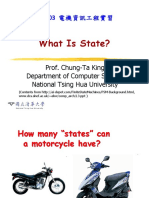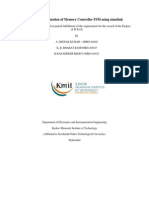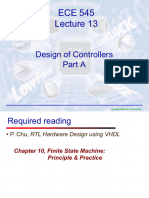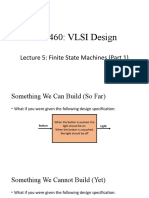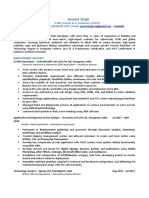FPGA Lab 11
Uploaded by
ihtisham ijaz mughalFPGA Lab 11
Uploaded by
ihtisham ijaz mughal2
Objective:
The main objective of this lab is to:
understand the concept of Finite State Machine.
Overview of real-life examples of FSM.
Difference between Moore and Mealy FSM.
Model and design the FSM for a given state transition diagram.
Design the state transition diagram and FSM for sequence detector.
Introduction:
A finite state machine (FSM) or simply a state machine is a mathematical model of
computation used to design both computer programs and sequential logic circuits. It is
conceived as an abstract machine that can be in one of a finite number of states. The machine
is in only one state at a time; the state it is in at any given time is called the current state. It
can change from one state to another when initiated by an external triggering event or
condition; this is called a transition. A particular FSM is defined by a list of its states, its
initial state, and the triggering condition for each transition.
Examples of FSM:
There are numerous real life FSM examples and some of them are discussed below.
1. Coin operated turnstile:
A turnstile, used to control access to subways and amusement park rides, is a gate with three
rotating arms at waist height, one across the entryway. Initially the arms are locked, blocking
the entry, preventing patrons from passing through. Depositing a coin or token in a slot on the
turnstile unlocks the arms, allowing a single customer to push through. After the customer
passes through, the arms are locked again until another coin is inserted. Considered as a state
machine, the turnstile has two states: Locked and Unlocked. The state transition diagram and
table is shown below.
2. Elevator Lift for Building:
IHTISHAM IJAZ MUGHAL Lab #11 2927
2
The second example of finite state machine is the building elevator. Suppose elevator is
stationary and the floor requested is below the current floor, and then descend the elevator to
the floor requested. If elevator is stationary and the floor requested is above the current floor,
then ascend the elevator to the floor requested. The State transition diagram for this system is
shown below.
In Xilinx ISE, XST proposes a large set of templates to describe Finite State Machines
(FSMs). By default, XST tries to recognize FSMs from VHDL/Verilog code, and apply
several state encoding techniques (it can re-encode the user's initial encoding) to get better
performance or less area. However, you can disable FSM extraction using
a FSM_extract design constraint. Please note that XST can handle only synchronous state
machines.
The basic block diagram of an FSM is the same as that of a regular sequential circuit and is
shown in Figures shown below. It consists of a state register, next state logic and output
logic. An FSM is known as Moore machine if the output is only a function of state, and is
known as Mealy machine if the output is the function of both state and external input.
Fig. 1 Moore based FSM
Fig. 2 Mealy based FSM
IHTISHAM IJAZ MUGHAL Lab #11 2927
2
State Transformation Diagram
Verilog Code
IHTISHAM IJAZ MUGHAL Lab #11 2927
2
Test Bench
IHTISHAM IJAZ MUGHAL Lab #11 2927
2
Output Wave
IHTISHAM IJAZ MUGHAL Lab #11 2927
You might also like
- Finite State Machines: Mor Vered, BIU University Multi Robot Systems Based On Lectures by George Mason and CMUNo ratings yetFinite State Machines: Mor Vered, BIU University Multi Robot Systems Based On Lectures by George Mason and CMU28 pages
- Lab Report: Practice 5: Finite State MachineNo ratings yetLab Report: Practice 5: Finite State Machine21 pages
- DigitalLogic ComputerOrganization L7 FSM HandoutNo ratings yetDigitalLogic ComputerOrganization L7 FSM Handout18 pages
- We Know That Synchronous Sequential Circuits ChangeNo ratings yetWe Know That Synchronous Sequential Circuits Change7 pages
- What Is State?: Prof. Chung-Ta King Department of Computer Science National Tsing Hua UniversityNo ratings yetWhat Is State?: Prof. Chung-Ta King Department of Computer Science National Tsing Hua University51 pages
- AN5 Finites State Machines With State MachineNo ratings yetAN5 Finites State Machines With State Machine3 pages
- Fpga Implementation of Memory Controller FSM Using Simulink2No ratings yetFpga Implementation of Memory Controller FSM Using Simulink257 pages
- Finite State Machines: State Diagrams vs. Algorithmic State Machine (ASM) ChartsNo ratings yetFinite State Machines: State Diagrams vs. Algorithmic State Machine (ASM) Charts46 pages
- General Finite State Machine (FSM) Design Moore/Mealy MachinesNo ratings yetGeneral Finite State Machine (FSM) Design Moore/Mealy Machines4 pages
- Logic Design: Design of Finite State Machines (Chapter 3)No ratings yetLogic Design: Design of Finite State Machines (Chapter 3)12 pages
- Finite State Machine: Varshini NarayanaNo ratings yetFinite State Machine: Varshini Narayana10 pages
- Lab No.10 Design of Finite State Machine ObjectivesNo ratings yetLab No.10 Design of Finite State Machine Objectives2 pages
- CSE460: VLSI Design: Lecture 5: Finite State Machines (Part 1)No ratings yetCSE460: VLSI Design: Lecture 5: Finite State Machines (Part 1)13 pages
- Lecture 4. Sequential Logic 2: Prof. Taeweon Suh Computer Science Education Korea UniversityNo ratings yetLecture 4. Sequential Logic 2: Prof. Taeweon Suh Computer Science Education Korea University35 pages
- Ise VHDL State Machine Process NEXYS3 SOENo ratings yetIse VHDL State Machine Process NEXYS3 SOE14 pages
- Investigation of the Usefulness of the PowerWorld Simulator Program: Developed by "Glover, Overbye & Sarma" in the Solution of Power System ProblemsFrom EverandInvestigation of the Usefulness of the PowerWorld Simulator Program: Developed by "Glover, Overbye & Sarma" in the Solution of Power System ProblemsNo ratings yet
- September Monthly Examination in Mathematic 10No ratings yetSeptember Monthly Examination in Mathematic 102 pages
- Religion Compass Volume 1 Issue 6 2007 (Doi 10.1111/j.1749-8171.2007.00043.x) Ann Jeffers - Magic and Divination in Ancient IsraelNo ratings yetReligion Compass Volume 1 Issue 6 2007 (Doi 10.1111/j.1749-8171.2007.00043.x) Ann Jeffers - Magic and Divination in Ancient Israel15 pages
- R - 04 X 1.PGM - Oxi Programming ExampleNo ratings yetR - 04 X 1.PGM - Oxi Programming Example7 pages
- 3.-Preguntas "WH" y "H": Question Words Spanish MeaningNo ratings yet3.-Preguntas "WH" y "H": Question Words Spanish Meaning2 pages
- LESSON PLAN Clasa 7-A A Baranga Triba IuliaNo ratings yetLESSON PLAN Clasa 7-A A Baranga Triba Iulia5 pages
- Two-Column Template For Conference Proceedings Based On IEEE Format (Title)No ratings yetTwo-Column Template For Conference Proceedings Based On IEEE Format (Title)3 pages
- Past Simple Reg Irreg Verbs Grammar Exercises 1c2ba Eso Curso 2013 14No ratings yetPast Simple Reg Irreg Verbs Grammar Exercises 1c2ba Eso Curso 2013 1413 pages
- Ground Vibration Management - Signatue Hole AnalysisNo ratings yetGround Vibration Management - Signatue Hole Analysis26 pages
- baixardoc.com-jyotishvedic-astrology-secret-revealed-kaal-purusha (1)No ratings yetbaixardoc.com-jyotishvedic-astrology-secret-revealed-kaal-purusha (1)10 pages
- Rev. 12:7 Then War Broke Out in Heaven Michael and His Angels Battled Against The DragonNo ratings yetRev. 12:7 Then War Broke Out in Heaven Michael and His Angels Battled Against The Dragon32 pages
- Swe2003 Requirements-Engineering-And-management Eth 1.0 47 Swe2003No ratings yetSwe2003 Requirements-Engineering-And-management Eth 1.0 47 Swe20032 pages
- (Ebook) Suppletion in Verb Paradigms: Bits and Pieces of the Puzzle by Ljuba N. Veselinova ISBN 9789027229793, 9789027293268, 9027229791, 9027293260 download pdf100% (3)(Ebook) Suppletion in Verb Paradigms: Bits and Pieces of the Puzzle by Ljuba N. Veselinova ISBN 9789027229793, 9789027293268, 9027229791, 9027293260 download pdf81 pages
- Developing, Deploying, and Monitoring in The CloudNo ratings yetDeveloping, Deploying, and Monitoring in The Cloud19 pages
- Finite State Machines: Mor Vered, BIU University Multi Robot Systems Based On Lectures by George Mason and CMUFinite State Machines: Mor Vered, BIU University Multi Robot Systems Based On Lectures by George Mason and CMU
- We Know That Synchronous Sequential Circuits ChangeWe Know That Synchronous Sequential Circuits Change
- What Is State?: Prof. Chung-Ta King Department of Computer Science National Tsing Hua UniversityWhat Is State?: Prof. Chung-Ta King Department of Computer Science National Tsing Hua University
- Fpga Implementation of Memory Controller FSM Using Simulink2Fpga Implementation of Memory Controller FSM Using Simulink2
- Finite State Machines: State Diagrams vs. Algorithmic State Machine (ASM) ChartsFinite State Machines: State Diagrams vs. Algorithmic State Machine (ASM) Charts
- General Finite State Machine (FSM) Design Moore/Mealy MachinesGeneral Finite State Machine (FSM) Design Moore/Mealy Machines
- Logic Design: Design of Finite State Machines (Chapter 3)Logic Design: Design of Finite State Machines (Chapter 3)
- Lab No.10 Design of Finite State Machine ObjectivesLab No.10 Design of Finite State Machine Objectives
- CSE460: VLSI Design: Lecture 5: Finite State Machines (Part 1)CSE460: VLSI Design: Lecture 5: Finite State Machines (Part 1)
- Lecture 4. Sequential Logic 2: Prof. Taeweon Suh Computer Science Education Korea UniversityLecture 4. Sequential Logic 2: Prof. Taeweon Suh Computer Science Education Korea University
- Investigation of the Usefulness of the PowerWorld Simulator Program: Developed by "Glover, Overbye & Sarma" in the Solution of Power System ProblemsFrom EverandInvestigation of the Usefulness of the PowerWorld Simulator Program: Developed by "Glover, Overbye & Sarma" in the Solution of Power System Problems
- Religion Compass Volume 1 Issue 6 2007 (Doi 10.1111/j.1749-8171.2007.00043.x) Ann Jeffers - Magic and Divination in Ancient IsraelReligion Compass Volume 1 Issue 6 2007 (Doi 10.1111/j.1749-8171.2007.00043.x) Ann Jeffers - Magic and Divination in Ancient Israel
- 3.-Preguntas "WH" y "H": Question Words Spanish Meaning3.-Preguntas "WH" y "H": Question Words Spanish Meaning
- Two-Column Template For Conference Proceedings Based On IEEE Format (Title)Two-Column Template For Conference Proceedings Based On IEEE Format (Title)
- Past Simple Reg Irreg Verbs Grammar Exercises 1c2ba Eso Curso 2013 14Past Simple Reg Irreg Verbs Grammar Exercises 1c2ba Eso Curso 2013 14
- Ground Vibration Management - Signatue Hole AnalysisGround Vibration Management - Signatue Hole Analysis
- baixardoc.com-jyotishvedic-astrology-secret-revealed-kaal-purusha (1)baixardoc.com-jyotishvedic-astrology-secret-revealed-kaal-purusha (1)
- Rev. 12:7 Then War Broke Out in Heaven Michael and His Angels Battled Against The DragonRev. 12:7 Then War Broke Out in Heaven Michael and His Angels Battled Against The Dragon
- Swe2003 Requirements-Engineering-And-management Eth 1.0 47 Swe2003Swe2003 Requirements-Engineering-And-management Eth 1.0 47 Swe2003
- (Ebook) Suppletion in Verb Paradigms: Bits and Pieces of the Puzzle by Ljuba N. Veselinova ISBN 9789027229793, 9789027293268, 9027229791, 9027293260 download pdf(Ebook) Suppletion in Verb Paradigms: Bits and Pieces of the Puzzle by Ljuba N. Veselinova ISBN 9789027229793, 9789027293268, 9027229791, 9027293260 download pdf
- Developing, Deploying, and Monitoring in The CloudDeveloping, Deploying, and Monitoring in The Cloud






















